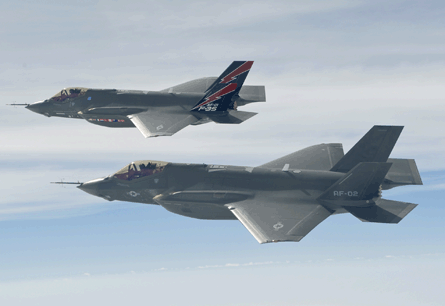The F-35 Joint Strike Fighter will be one of the key talking points at the show, with Lockheed Martin's poster product having received mixed support in the lead-up to the event.
Canada's government on 16 July made a formal commitment to buy 65 F-35s, in a move intended to qualify its national industry to bid for more work on the fifth-generation fighter.
But the most important buyer for the JSF - programme executive officer Vice Adm David Venlet - is foregoing an appearance at the show, to instead focus on executing a programme restructuring unveiled on 1 February, the US Department of Defense says.
The no-show by Venlet mirrors a decision by Lockheed chief executive Robert Stevens to also stay away, after citing a corporate goal to respond to a "new reality" of slower growth for military spending by cutting back on executive expenses.
 |
|---|
© Lockheed Martin |
Ottawa has valued the cost of its F-35 acquisition at C$9 billion ($8.5 billion), or about C$138 million per aircraft, including engines, weapons and sensors.
An additional maintenance support deal is expected to add multiple billions of dollars more, but a contract signature is not required until at least 2013. The Canadian air force should receive its first aircraft in 2016.
Critics in Canada's Labour Party attacked the Harper government for making a sole-source commitment six years in advance of delivery. Other options had included Boeing's F/A-18E/F Super Hornet and the Eurofighter Typhoon.
But Minister of Industry Tony Clement says the early commitment "ensures that Canadian companies will have opportunities to compete for contracts". Local firms have received about C$350 million in F-35-related work over the last eight years.
"International commitment from the partners has solidified, and FMS [Foreign Military Sales] interest is growing," says Steve O'Bryan, Lockheed's vice-president business development for the F-35.
Speaking to Flightglobal at the Royal international Air Tattoo on Friday, O'Bryan said Israel, Japan, Singapore and South Korea all represent near-term sales opportunities.
The F-35 test fleet had logged a combined 155 sorties this year, against a planned target of 136, by 15 July. They should log almost 400 flights in 2010.
"The programme is in excellent shape," O'Bryan says. "We're going to be rolling operational jets off the line within the next 30 days."
But rival manufacturers are challenging Lockheed's claim that the F-35 belongs to a superior generation of fighters along with its F-22 Raptor.
Boeing says the Super Hornet's advanced sensors and cockpit displays qualify it as a "next-generation" aircraft, while Eurofighter has attacked the F-35 as inferior to the Typhoon in several categories, except all-aspect radar stealth.
Source: Flight Daily News























